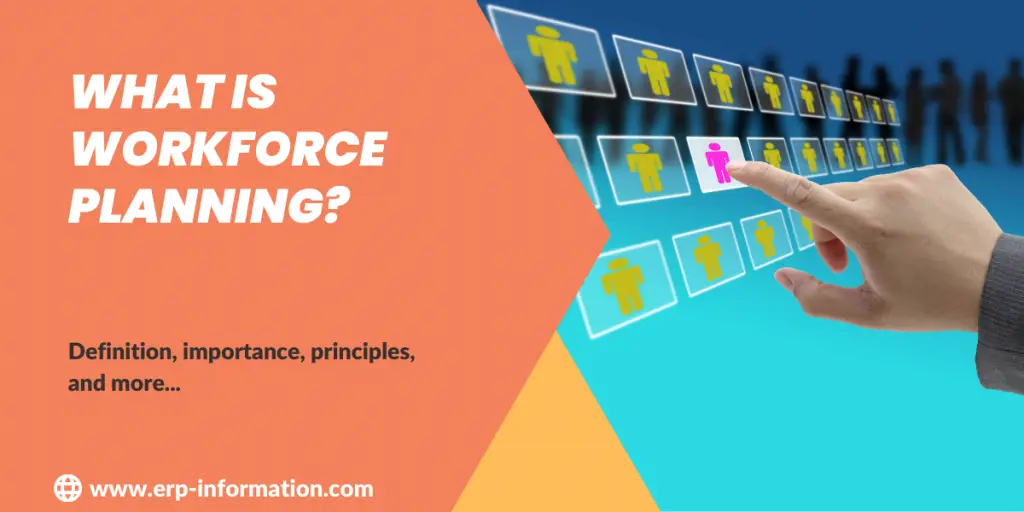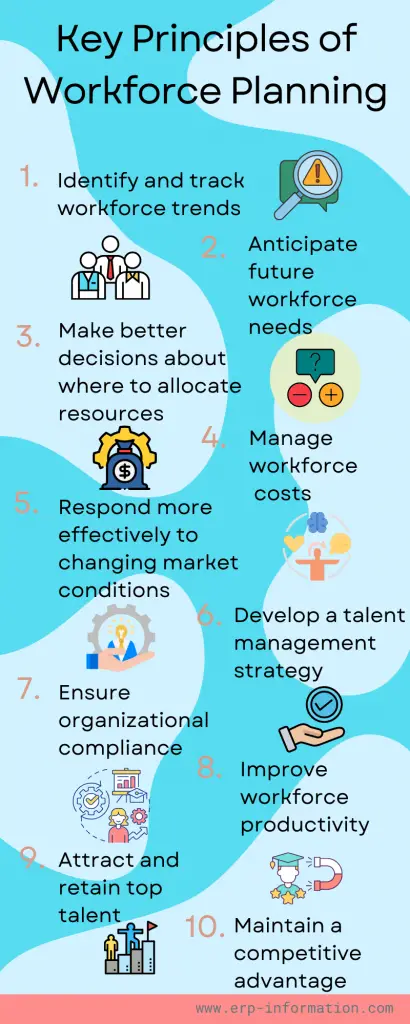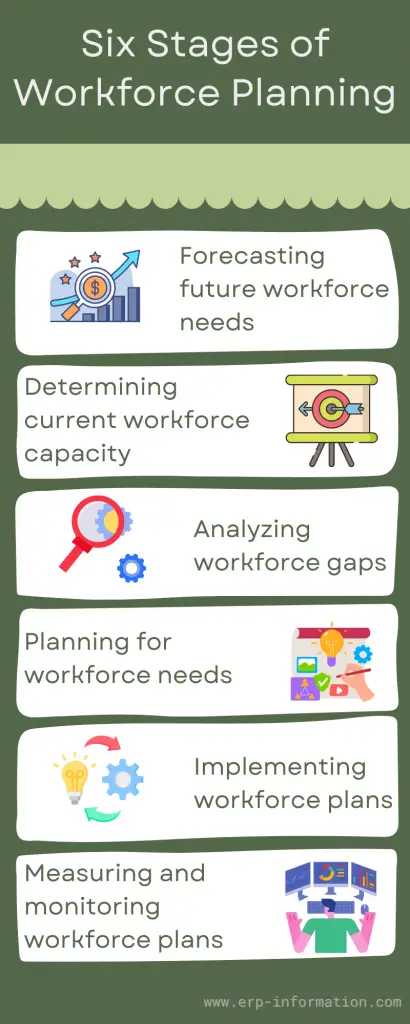Workforce planning is critical for all businesses, but knowing where to start or what principles to follow can take work.
With a workforce plan in place, you may find yourself able to fill positions when they become vacant or, worse, have too many employees on staff.
This blog post will introduce you to the definition of workforce planning, explain its importance, and provide steps and principles to follow when creating your workforce plan and the challenges.
Evaluate Workforce planning using our Online Workforce Planning Calculator
What is workforce planning?
Workforce planning accurately depicts the workforce that a company will need to achieve its strategic objectives. Or in other words, it is the process of forecasting, planning, and analyzing workforce supply and demand.
It also includes the determination of gaps between supply and demand and the evaluation of current staff.
Why is it important?
It is important because it allows an organization to identify and anticipate future workforce needs and gaps. It helps organizations match the right people with the same jobs.
Finally, it involves creating a strategy for allocating resources within an organization to meet its strategic objectives.
Strategic workforce planning
It is a dynamic method to manage the workforce with business goals. It ensures that the workforce aligns with the organization’s purpose and long-term vision. It happens at a higher level and focuses on goals like
- Evaluation of current talent
- Prediction of future talent needs
- Staffing budgets
- Risk reduction
- Implementation of an effective strategy for workforce analyzation
Operational workforce planning
On the other hand, operational workforce planning focuses on streamlining staff’s daily operations. That includes priorities of the workday, maintaining productivity, etc.
This model helps to determine gaps within the organization and allocate those available talents throughout the organization.
Key principles
Identify and track workforce trends
Organizations must identify and track workforce trends. By monitoring workforce trends, organizations can adapt their workforce plans to ensure they are prepared for the future.
Anticipate future workforce needs
Organizations anticipate future workforce needs. By anticipating future needs, organizations can ensure they have the right workforce when those needs arise.
That allows them to be more responsive to changes in the business environment and better meet the marketplace’s demands.
Make better decisions about where to allocate resources
Organizations can forecast future workforce needs by aligning workforce supply with those needs. That allows them to utilize their resources better and optimize their workforce.
Manage workforce costs
It allows organizations to plan and manage their workforce costs strategically. When reducing costs, organizations should keep several workforce planning principles in mind, such as workforce optimization, alignment, and capacity.
By following these principles, organizations can ensure they get the most out of their workforce and minimize costs.
Respond more effectively to changing market conditions
Businesses must respond more effectively to changing market conditions to remain competitive, which can impact everything from workforce size to the skills required. It can help facilitate this by ensuring that the workforce is organized in a way that allows for quick adaptation.
Develop a talent management strategy
It is not just about forecasting future workforce needs. It’s also about developing a talent management strategy. A talent management strategy involves identifying and nurturing the talent that your business will need in the future.
It’s important to have a plan for recruiting and developing new talent and retaining the talent you already have.
Ensure organizational compliance
This planning must take into account compliance with all applicable laws and regulations. That includes equal employment opportunity requirements, wage and hour laws, and health and safety regulations.
Failing to comply with these laws can result in costly fines and other penalties for the organization.
Improve workforce productivity
Organizations can improve their bottom line by ensuring the right workforce is in place and working efficiently and productively.
There are several principles to workforce planning, including workforce alignment with strategic objectives, analysis, forecasting, and management. Each workforce planning process step is important to create a productive and effective workforce.
Attract and retain top talent
By having a strategic workforce plan, organizations can identify the key areas they need to focus on to find and keep the best employees. Retaining talented employees is important for maintaining workforce stability and ensuring that your business has the skills it needs to succeed.
Maintain a competitive advantage
By having a strategic workforce plan, organizations can ensure that they have the right employees with the right skills in the right places at the right times.
That allows organizations to become more agile and responsive to changes in the market and better compete for customers and talent.
Six stages of workforce planning
The below image shows the workforce planning methodology.
1) Forecasting future workforce needs
It begins by forecasting future workforce needs. But first, organizations need to anticipate the number of employees they will need to make strategic decisions about what positions to fill and when.
Forecasting is a challenging task requiring a lot of research and analysis. However, the most important part is to use accurate data and to be realistic about future trends.
2) Determining current workforce capacity
Once the organization has forecasted future workforce needs, the next step is determining current workforce capacity. That means assessing how many employees the organization currently has and how many positions are now filled.
It’s important to consider skillsets, experience levels, and other factors when making this assessment. In addition, determining workforce capacity is essential for determining what positions must be filled and when.
3) Analyzing workforce gaps
Workforce gaps can be analyzed by looking at the supply and demand of workers in a particular industry or sector, focusing on meeting current or future needs.
By understanding the gap, workforce planners can devise plans to fill it and ensure that their workforce can meet the needs of the business.
Workforce planners use various data sources to identify potential workforce gaps, including demographic data, labor cost, labor market information, and skill assessments.
Click here to get an online Labor Productivity Calculator
4) Planning for workforce needs
planning for workforce needs means forecasting future requirements and ensuring the workforce has the appropriate skills and capabilities to meet those needs. It involves considering factors such as workforce demographics, business growth and expansion, and technological changes.
5) Implementing workforce plans
Once a workforce plan is created, it needs to be implemented effectively to be effective. That requires communication between managers and employees and tracking of progress against objectives.
6) Measuring and monitoring workforce plans
It is an important process that helps organizations ensure they have the correct number and types of employees to meet their strategic goals. Workforce plans should be regularly monitored and updated to reflect changes in the business environment and workforce needs.
The steps involved in workforce planning vary depending on the organization’s size and complexity. However, the process generally begins with assessing current and future workforce needs.
That is followed by determining how best to meet those needs, considering factors such as budget constraints and available resources. Finally, once the plan is finalized, it must be implemented and monitored to ensure effectiveness.
Challenges of Workforce planning
Poor skills and knowledge of employees
Poor skills and knowledge of employees will affect workforce planning. This can mean that their skills need to be upgraded with training. If there is no plan for training employees, they cannot work well or be efficient because they do not have the right skills and knowledge.
Lack of transparency
Lack of transparency in the company’s decisions makes employees less interested in their work. Companies need to be more open about staffing plans, so employees know what is happening.
Lack of planning
If a company does not plan carefully when hiring people, it might hire the wrong person. If this happens, replacing an employee takes time and money, which can slow down the company’s growth.
Challenge of utilizing employee skills
Workforce planning is to be done carefully to utilize employee skills. Without a good plan, the organization won’t have the right skills and resources to do its work. This means employees could be too busy or not skilled enough to complete their jobs.
Lack of developing a leadership pipeline
Developing a leadership pipeline is very important to plan the future. If they do not plan enough, it can lead to bad results, like not having enough leaders in the company.
Improper collaboration
Improper collaboration between employees may badly affect new innovations of the company. When planning the workforce, the company should ensure that teams are connected so they can share ideas, communicate easily, and work together. If you don’t have a proper plan, employees won’t collaborate, and the company won’t grow or create new ideas.
What is the difference between Data virtualization and data federation?
Data federation combines data from many sources and can be seen in one place. Data virtualization means all of the technical details about that data.
Conclusion
Workforce planning is forecasting future workforce needs and ensuring that the organization has the right number and types of employees, with the necessary skills, at the right time and place.
Workforce planning is important because it allows organizations to be strategic in hiring decisions, leading to increased efficiency and productivity.
This post outlines the workforce planning process, which includes principles and steps organizations can take to be successful.


